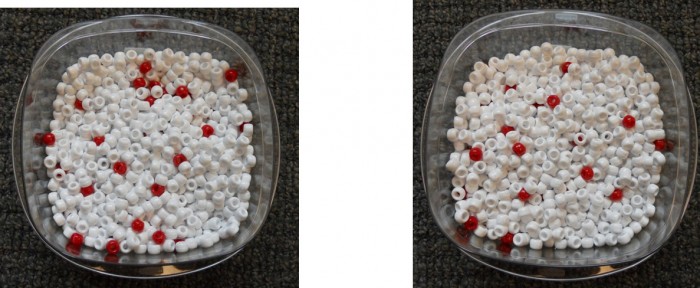Folks,
Some time ago, I posted on the limits of mixing. In modern manufacturing, there may be some applications that require two metal powders to be evenly distributed, say on a surface. Let’s further say that the mixture is 90% of powder A and 10% of powder B. The requirement is that no clusters of 3 particles of B should be together and in any area of 30 particles of A, there should be at least one B particle. On first thought, it would appear that these requirements would be easy to achieve by mixing the powders.
It ends up that due to randomness, this objective is not possible. I developed anExcel® spreadsheet to perform this experiment virtually. See Figure 1. A “1’ represents particle B and a “0” particle A. The programming in the spreadsheet randomly places the 0s and 1s consistent with the 90/10 requirement. Note that there are at least two incidences of 3 of particle B clustered. These “1s” are in red. Also, notice the rectangle of 35 blue “0”s (particle A.) Therefore, neither criteria in the first paragraph is achieved.

Figure 1. Mixing will almost always produce clusters (in red) and vacancies (in blue).
The reason for this lack of success is the randomness of mixing. There is always a certain probability of clusters of 1s and “vacancies"of 1s. Further mixing just causes these clusters or vacancies of B to move.
Consider the photos of the red and white beads below in Figure 2. The red beads are 5% of the total. Which do you think is random? Often people will assume it is the one on the right because of the even spacing of the red beads. It ends up that the photo on the left is from mixing and the photo on the right is staged. Mixing will usually result in clumping of red beads that is evident in the left photo. I have tried hundreds of times to mix the beads and always get a few clumps.

Figure 2. The figure on the left is from mixing;that on the right is staged.
This effect is also observed when we look at stars. They too are in clumps, although gravitation does exacerbate this clumping effect.
Cheers,
Dr. Ron



